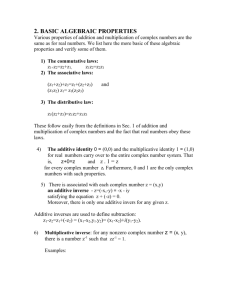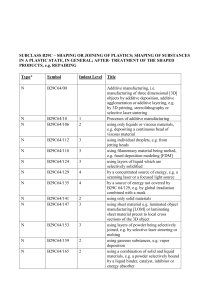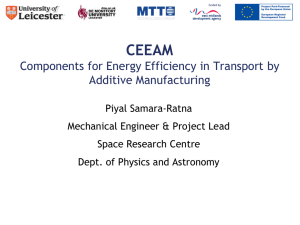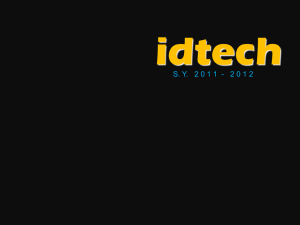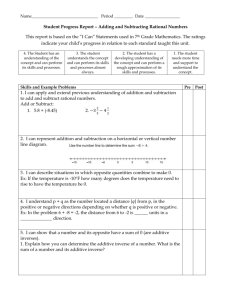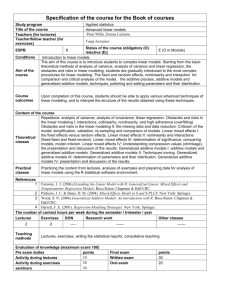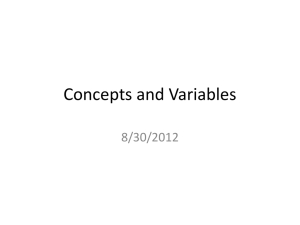Additive Manufacturing is conquering the industrial sector
advertisement
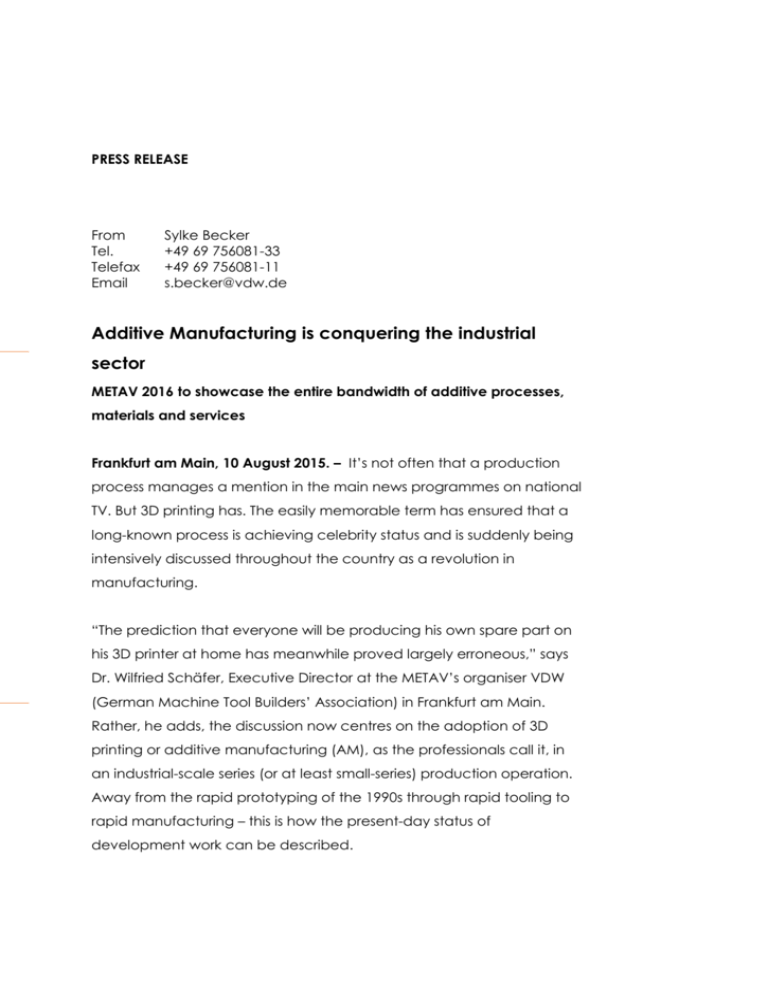
PRESS RELEASE From Tel. Telefax Email Sylke Becker +49 69 756081-33 +49 69 756081-11 s.becker@vdw.de Additive Manufacturing is conquering the industrial sector METAV 2016 to showcase the entire bandwidth of additive processes, materials and services Frankfurt am Main, 10 August 2015. – It’s not often that a production process manages a mention in the main news programmes on national TV. But 3D printing has. The easily memorable term has ensured that a long-known process is achieving celebrity status and is suddenly being intensively discussed throughout the country as a revolution in manufacturing. “The prediction that everyone will be producing his own spare part on his 3D printer at home has meanwhile proved largely erroneous,” says Dr. Wilfried Schäfer, Executive Director at the METAV’s organiser VDW (German Machine Tool Builders’ Association) in Frankfurt am Main. Rather, he adds, the discussion now centres on the adoption of 3D printing or additive manufacturing (AM), as the professionals call it, in an industrial-scale series (or at least small-series) production operation. Away from the rapid prototyping of the 1990s through rapid tooling to rapid manufacturing – this is how the present-day status of development work can be described. Page 2 / 7 METAV 2016 This theme is being addressed with a new concept adopted by the METAV, 19th International Exhibition for Metalworking Technologies in Düsseldorf. Under the motto of “Power your Business”, it will from 23 to 27 February 2016 in the Additive Manufacturing Area be showcasing the entire bandwidth of additive processes, materials and service capabilities themed around 3D printing. The METAV is thus expanding and supplementing its presentation of production technology for all sectors, particularly the manufacture of metal components, for mechanical engineering, aircraft, automobile and tool manufacturing, and medical technology. Additive manufacturing is intermeshed as a production process with other key elements in the metalworking value creation chain, chief among them CAD and simulation, reworking, production metrology and quality assurance. Besides AM systems pure and simple, hybrid concepts are also being created, which combine AM processes with traditional machining. “This is for many users a very interesting solutional approach,” says Wilfried Schäfer from the VDW. Additive Manufacturing Area spotlights plastic and metal applications The advantages of additive manufacturing are obvious. Firstly, new design ideas and product concepts with new functions now become possible, because highly complex geometries are feasible, which with conventional processes have hitherto proved impossible or prohibitively costly to manufacture. Secondly, efficiency gains are achieved in terms of time and material consumption. Functions can now be integrated directly in a single production step. This is also an attractive option for component functionality in terms of material optimisation. Additive manufacturing is therefore already playing a significant role in lightweight construction of aircraft and automobile parts particularly. Thirdly, the manufacturer can responsively meet individual customers’ Page 3 / 7 METAV 2016 wishes – provided the user concerned possesses the requisite experience. Exhibitors are welcoming this initiative from the METAV’s organiser VDW. Stefan Ritt of SLM Solutions in Lübeck, for example, says: “Additive processes create new options for lightweight construction and complex structures. The Additive Manufacturing Area showcases these potentials in plastic and metal applications.” He also notes appreciatively that important customer segments for additive processes, like tool and mould manufacturers and medical technology producers, are being specifically addressed at the METAV with the Moulding Area and the Medical Area. Many of these advantages are exemplified by the robot grippers of robomotion GmbH from Leinfelden-Echterdingen. This company uses additively manufactured components in series production. Thanks to 3D printing, the grippers can be individually matched to the geometry of the product concerned. Whether it’s sausages or chocolate eggs – the gripper fingers shaped specifically for their contours grip them gently and deftly. Thanks to small-series production on laser-sintering lines, individual customisation is not only affordable, it also opens the way to new functions. This enables springs to be easily integrated into the fingers of the grippers, which means they can adapt to products of different sizes, thus minimising the make-ready times at the customer’s plant. Thanks to layer-by-layer deposition, moreover, air channels, hose mountings and cylinders of the pneumatic actuators can be accommodated directly in the grippers. “The advantages are obvious: the grippers can be made more compact and lighter,” says Dr. Andreas Wolf, Managing Director of robomotion. Meanwhile, other machine components are also being additively manufactured, such as sensors and flange plates. Page 4 / 7 METAV 2016 “There are, of course, plenty of challenges still to be mastered”, admits Rainer Gebhardt, an expert in the Additive Manufacturing Working Group of the German Engineering Federation (VDMA). For instance, the manual contents in the process chains of additive manufacturing are still high at present. This is why vendors and users of additive production methods are in the working group collaborating intensively to progress the industrialisation of AM production processes and automation. For this purpose, good comprehension of the entire operation concerned is vital, starting with the material, then preparatory and follow-up production, all the way through to the manufacturing process and quality acceptance-testing of the components as such. Research work in the field of additive manufacturing deals with assuring quality, e.g. reproducibility, with the use of new materials and enhanced cost-efficiency in production operations. It is clearly emerging that the causal connection between the parameters set during production and the quality features at the finished part in many cases needs to be researched more precisely. The goal is in future to enable characteristics of the component to be assured within close tolerances by means of appropriate settings at the machine. At the METAV 2016, too, quality assurance is a major focus in the Quality Area. The METAV accordingly provides an ideal platform for discussing the ongoing challenges with all the parties involved: manufacturers, users, the academic community, material producers and service providers. This is not least the reason why the Additive Manufacturing Working Group in the German Engineering Federation (VDMA) is represented at the METAV. “The appropriate use of additive manufacturing is a crucial key for attaining competitive advantages in the mechanical engineering sector,” says Rainer Gebhardt. “We regard the Additive Manufacturing Area at the METAV as a very good opportunity to progress solutions to ongoing issues and to further publicise the working Page 5 / 7 METAV 2016 group and its capabilities on the market.” Under the aegis of the associated forum, for instance, the exhibitors in the Additive Manufacturing Area will be showcasing their best-practice solutions with 3D printing, whether it’s with laser-sintering of plastics, laser-welding of metals, or a combination of conventional and additive processes. Added value from an attractive congress and supporting programme Another partner for the Additive Manufacturing Area at the METAV is Rising Media. This congress organiser from Santa Barbara, California, is hosting one of the biggest and most important international conferences for specialists in the field of 3D printing: the Inside 3D Printing. The Inside 3D Printing 2016 is being held on 24 and 25 February 2016 in conjunction with the METAV, in the Düsseldorf Exhibition Centre. It sees its role as a forum for mutual feedback between professionals in the field of additive manufacturing processes, and attracts internationally prestigious speakers, who report on issues from the entire value creation chain, from research all the way through to the enduser. “We provide a forum for experts, scientists, service providers, dealers and investors from all over the world,” says Dr. Eric Klemp, Executive Director of the Direct Manufacturing Research Centre (DMRC) at Paderborn University and the man responsible for the conference’s programme. “They no longer need any elucidation of the basics involved, what they want instead is to explore the limits of the methods available today for 3D printing,” he proceeds to explain. The alliance with the METAV, he adds, offers those attending the congress a hands-on experience above and beyond the presentations, since all participants have free access to the fair. Important equipment manufacturers and technology suppliers are represented here, as are service providers and research institutes. Page 6 / 7 METAV 2016 Under the aegis of the Additive Manufacturing Area at the METAV and the Inside 3D Printing conference, finally, the International Additive Manufacturing Award (IAMA), worth a total of 100,000 US-dollars, is bestowed. This award is designed as an accolade for innovations from the industrial sector and the academic community along the value creation chain involved in additive manufacturing. The AMT, the USA’s Association for Manufacturing Technology, and the VDW premiered the IAMA to the public at the IMTS (International Manufacturing Technology Show) in September 2014. Since 2015 it is being jointly awarded on an annual basis. Number of characters including blanks: 9,458 Background to the METAV 2016 in Düsseldorf The METAV 2016 – the 19th International Exhibition for Metalworking Technologies – will be held in Düsseldorf from 23 to 27 February. It showcases the entire spectrum of production technology. The principal focuses are machine tools, production systems, high-precision tools, automated material flows, computer technology, industrial electronics, and accessories, complemented by the new themes of Moulding, Medical, Additive Manufacturing and Quality, which are now permanently anchored in what are called “areas” with their own nomenclature in the METAV’s exhibition programme. The METAV’s target group for visitors includes all branches of industry that work metal, particularly machinery and plant manufacturers, the automotive industry and its component suppliers, aerospace, the electrical engineering industry, energy and medical technologies, tool and mould-making, plus metalworking and the craft sector. Further information: www.metav.de Portrait of the Additive Manufacturing Working Group in the German Engineering Federation (VDMA) The Additive Manufacturing Working Group brings together all the parties involved along the value creation chain of industrial-scale additive manufacturing: both researchers and material vendors, equipment manufacturers and service providers, all the way through to users from the plant and machinery manufacturing sector. Currently 90 members of the Additive Manufacturing Working Group are benefiting primarily from know-how transfer. The main focus of their work is on automation and machine acceptance-testing for additive manufacturing. Further information: http://am.vdma.org Page 7 / 7 METAV 2016 You will find texts and pictures about the METAV 2016 on the internet under www.metav.de In the Press Service. You can also visit the METAV through our social media channels http://twitter.com/METAV_ONLINE http://facebook.com/METAV.fanpage http://www.youtube.com/metaltradefair https://de.industryarena.com/metav
